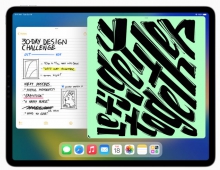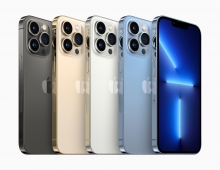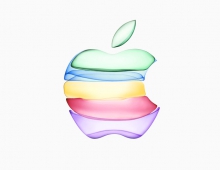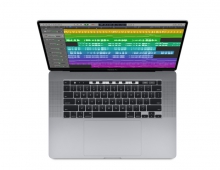New iPad 32GB And 4G Carries $364.35 BOM
Apple's new iPad models are more expensive to produce
than the iPad 2 at time of launch, according to market
research firm IHS iSuppli.
The new iPad, equipped with 32 Gigabytes (GB) of NAND
flash memory and 4G Long Term Evolution (LTE) wireless
capability, carries a bill of materials (BOM) of $364.35,
according to the research firm. When the $10.75
manufacturing costs are added in, the cost to produce the
new iPad rises to $375.10. The BOM of the 16GB 4G LTE
version amounts to $347.55, and the 64GB version is
estimated at $397.95.
The $364.35 BOM represents 50 percent of the $729.00 retail price of the 32GB LTE version of the new iPad.
The very lowest-end version of the new iPad, with 16GB memory and no LTE, carries a combined BOM and manufacturing cost of $316. The highest-end model, with 64GB memory and integrated LTE, has a total BOM and manufacturing expense of $408.70, iSuppli added.
iSuppli aknowledged that those teardown assessments were preliminary in nature, account only for hardware and manufacturing costs and did not include additional expenses such as software, licensing, royalties or other expenditures.
The new iPad is more expensive to produce than the iPad 2 at the time of product launch, even though the retail price points are the same. The 32GB LTE model's BOM is nearly 9 percent higher than an iPad 2 equipped with 32GB and 3G wireless, which carried a cost of approximately $335 at the time of product launch. Major factors driving up the BOM include the addition of the high-resolution Retina display, LTE wireless and a larger-capacity battery.
The table below summarizes the major components in the new iPad.
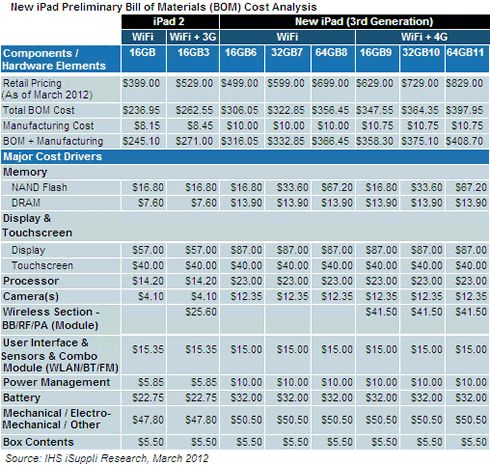
Among all component suppliers, Samsung Electronics continues its reign as the big winner in the individual iPad analyzed by the IHS iSuppli Teardown Analysis Service. The report says that Samsung supplied both the display and the applications processor. The new iPad's Retina display represents the most expensive single component in the tablet, at $87, while the applications processor costs an estimated $23. Combined, this gives Samsung a 30.2 percent share of the 32GB LTE version of the new iPad?s bill of materials, the largest for any supplier.
In the individual new iPad analyzed, the NAND flash was supplied by Toshiba. However, Samsung also is a source of NAND for the new iPad. In a 32GB LTE iPad where Samsung is also the supplier of the NAND, Samsung's share of the BOM rises by $33.60 to a total of $143.60, amounting to 39.4 percent of the total BOM. However, Toshiba, Hynix Semiconductor and others also are all NAND suppliers to Apple, and each will claim a portion of those revenues.
IHS believes that the battery cells are supplied by Samsung. If this turns out to be the case, Samsung will account for nearly 50 percent of the new iPad's BOM.
The new iPad's Retina display has a resolution of 2,048 by 1,536 pixels. It costs $87, compared to $57 for the screen used in the iPad 2. The $87 cost accounts for 24 percent of the BOM of the new iPad with 32GB NAND and LTE, making the Retina display the most expensive single component in the tablet.
IHS believes Apple likely has qualified three sources for the display in the new iPad: Samsung, LG Display and Sharp. However, the firm says that all the volume shipments of the new iPad display are currently coming from Samsung.
The touch screen for the new iPad costs an estimated $40, or 10.9 percent of the total BOM. As in the iPad 2, the main suppliers in this area are still TPK, Wintek and Chi Mei.
The wireless section costs $41.50 and accounts for 11.4 percent of the BOM. Because this section provides support for the LTE capabilities of the new iPad, it is significantly more expensive than the $25.60 wireless section of the iPad 2, which supported the 3G air standard. The big winner in this section is Qulcomm Inc., whose MDM9600 baseband processor provides the core LTE functionaility. IHS believes that the wireless section is the same for both AT&T and Verizon versions of the new iPad, although that hasn't been confirmed yet.
The A5X applications processor costs $23, and represents 6.3 percent of the total BOM. Samsung manufactures the A5X for Apple. However, for this device, Samsung serves as a foundry partner to Apple, and not as an independent semiconductor supplier. Apple is the designer and owner of the intellectual property of the A5X, and Samsung manufactures the part on a contract basis. This means that Samsung likely commands a lower margin on the device that it would otherwise.
"The NAND flash memory is one of the key profit-generating components for Apple in the new iPad line, as it has been in previous iPads and in the iPhone family," noted Andrew Rassweiler, senior principal analyst, teardown services, at IHS. "Apple makes far and away more money in selling consumers NAND flash than NAND flash manufacturers make selling it to Apple. And the more flash in the iPad, the higher the profit margin there is for Apple."
The new iPad camera module design and cost is the same as in the iPhone 4 camera module. The two camera modules cost a combined $12.35, representing 3.4 percent of the BOM.
The battery delivers a major upgrade from the previous model. The lithium polymer battery in the new iPad supports 42.5 watt hours, up about 75 percent from 25 watt hours in the iPad 2. However, because of price decreases during the past year, the new battery costs only 40 percent more than the old one, at $32.00, compared to $22.75 for the one in the iPad 2.
The $364.35 BOM represents 50 percent of the $729.00 retail price of the 32GB LTE version of the new iPad.
The very lowest-end version of the new iPad, with 16GB memory and no LTE, carries a combined BOM and manufacturing cost of $316. The highest-end model, with 64GB memory and integrated LTE, has a total BOM and manufacturing expense of $408.70, iSuppli added.
iSuppli aknowledged that those teardown assessments were preliminary in nature, account only for hardware and manufacturing costs and did not include additional expenses such as software, licensing, royalties or other expenditures.
The new iPad is more expensive to produce than the iPad 2 at the time of product launch, even though the retail price points are the same. The 32GB LTE model's BOM is nearly 9 percent higher than an iPad 2 equipped with 32GB and 3G wireless, which carried a cost of approximately $335 at the time of product launch. Major factors driving up the BOM include the addition of the high-resolution Retina display, LTE wireless and a larger-capacity battery.
The table below summarizes the major components in the new iPad.

Among all component suppliers, Samsung Electronics continues its reign as the big winner in the individual iPad analyzed by the IHS iSuppli Teardown Analysis Service. The report says that Samsung supplied both the display and the applications processor. The new iPad's Retina display represents the most expensive single component in the tablet, at $87, while the applications processor costs an estimated $23. Combined, this gives Samsung a 30.2 percent share of the 32GB LTE version of the new iPad?s bill of materials, the largest for any supplier.
In the individual new iPad analyzed, the NAND flash was supplied by Toshiba. However, Samsung also is a source of NAND for the new iPad. In a 32GB LTE iPad where Samsung is also the supplier of the NAND, Samsung's share of the BOM rises by $33.60 to a total of $143.60, amounting to 39.4 percent of the total BOM. However, Toshiba, Hynix Semiconductor and others also are all NAND suppliers to Apple, and each will claim a portion of those revenues.
IHS believes that the battery cells are supplied by Samsung. If this turns out to be the case, Samsung will account for nearly 50 percent of the new iPad's BOM.
The new iPad's Retina display has a resolution of 2,048 by 1,536 pixels. It costs $87, compared to $57 for the screen used in the iPad 2. The $87 cost accounts for 24 percent of the BOM of the new iPad with 32GB NAND and LTE, making the Retina display the most expensive single component in the tablet.
IHS believes Apple likely has qualified three sources for the display in the new iPad: Samsung, LG Display and Sharp. However, the firm says that all the volume shipments of the new iPad display are currently coming from Samsung.
The touch screen for the new iPad costs an estimated $40, or 10.9 percent of the total BOM. As in the iPad 2, the main suppliers in this area are still TPK, Wintek and Chi Mei.
The wireless section costs $41.50 and accounts for 11.4 percent of the BOM. Because this section provides support for the LTE capabilities of the new iPad, it is significantly more expensive than the $25.60 wireless section of the iPad 2, which supported the 3G air standard. The big winner in this section is Qulcomm Inc., whose MDM9600 baseband processor provides the core LTE functionaility. IHS believes that the wireless section is the same for both AT&T and Verizon versions of the new iPad, although that hasn't been confirmed yet.
The A5X applications processor costs $23, and represents 6.3 percent of the total BOM. Samsung manufactures the A5X for Apple. However, for this device, Samsung serves as a foundry partner to Apple, and not as an independent semiconductor supplier. Apple is the designer and owner of the intellectual property of the A5X, and Samsung manufactures the part on a contract basis. This means that Samsung likely commands a lower margin on the device that it would otherwise.
"The NAND flash memory is one of the key profit-generating components for Apple in the new iPad line, as it has been in previous iPads and in the iPhone family," noted Andrew Rassweiler, senior principal analyst, teardown services, at IHS. "Apple makes far and away more money in selling consumers NAND flash than NAND flash manufacturers make selling it to Apple. And the more flash in the iPad, the higher the profit margin there is for Apple."
The new iPad camera module design and cost is the same as in the iPhone 4 camera module. The two camera modules cost a combined $12.35, representing 3.4 percent of the BOM.
The battery delivers a major upgrade from the previous model. The lithium polymer battery in the new iPad supports 42.5 watt hours, up about 75 percent from 25 watt hours in the iPad 2. However, because of price decreases during the past year, the new battery costs only 40 percent more than the old one, at $32.00, compared to $22.75 for the one in the iPad 2.

